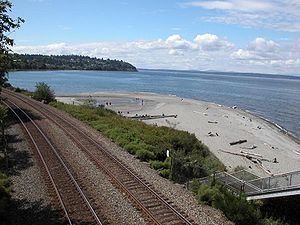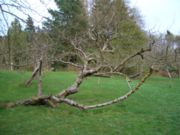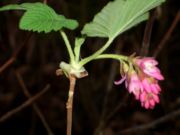
Carkeek Park
Encyclopedia

Park
A park is a protected area, in its natural or semi-natural state, or planted, and set aside for human recreation and enjoyment, or for the protection of wildlife or natural habitats. It may consist of rocks, soil, water, flora and fauna and grass areas. Many parks are legally protected by...
located in the Broadview
Broadview, Seattle, Washington
Broadview is a neighborhood in northwestern Seattle, Washington, USA.Broadview is bounded on the west by Puget Sound; on the north by N.W. 145th Street, beyond which is the city of Shoreline; on the east by Greenwood Avenue N., beyond which lies the neighborhood of Bitter Lake; and on the south by...
neighborhood of Seattle, Washington. The park contains Piper Orchard
Piper Orchard
Piper Orchard is a fruit orchard containing primarily heirloom apple trees, located within Seattle Washington's Carkeek Park.-Early:The orchard was planted in what was then the homestead of notable Seattle settler A.W...
, Pipers Creek
Pipers Creek
Pipers Creek is a urban stream in the Broadview and Blue Ridge neighborhoods of Seattle, Washington, whose entire length is within the boundaries of Carkeek Park. Its tributaries are Venema Creek and Mohlendorph Creek. It empties into Puget Sound. The creek was renamed "Piper's" by early White...
(and its tributaries Venema Creek and Mohlendorph Creek), play and picnic areas, picnic shelters, and hiking trails. A pedestrian bridge across the main lines of the BNSF Railway
BNSF Railway
The BNSF Railway is a wholly owned subsidiary of Berkshire Hathaway Inc., and is headquartered in Fort Worth, Texas. It is one of seven North American Class I railroads and the second largest freight railroad network in North America, second only to the Union Pacific Railroad, its primary...
connects to the Carkeek Park sand beach on Puget Sound
Puget Sound
Puget Sound is a sound in the U.S. state of Washington. It is a complex estuarine system of interconnected marine waterways and basins, with one major and one minor connection to the Strait of Juan de Fuca and the Pacific Ocean — Admiralty Inlet being the major connection and...
. Park program activities are largely out of the Carkeek Park Environmental Education Center.
Vehicles can enter the park from either NW 117th Street or NW 110th Street via Carkeek Park Road, a winding drive down a steep wooded hillside. Park access is more pedestrian-friendly. Pedestrians can reach the park at NW 117th Street (near 12th Avenue NW), 12th Avenue NW (near NW 116th Street), NW 116th Street (near the main vehicle entrance), NW 107th Street (near 4th Avenue NW), NW 105th Street (near 3rd Avenue NW), NW 100th Place (near 6th Avenue NW), and NW Norcross Way (near 12th Avenue NW).
Seattle's first park to be called Carkeek Park was on Pontiac Bay, Lake Washington
Lake Washington
Lake Washington is a large freshwater lake adjacent to the city of Seattle. It is the largest lake in King County and the second largest in the state of Washington, after Lake Chelan. It is bordered by the cities of Seattle on the west, Bellevue and Kirkland on the east, Renton on the south and...
(1918–1926), now site of Magnuson Park. The original was a gift of Mr. and Mrs. Morgan J. Carkeek, prominent builder and contractor in Seattle, Oregon, and Victoria, B.C. The original was displaced by a Naval Air Station. Morgan Carkeek offered the proceeds of his sale to the City for another park.

Works Progress Administration
The Works Progress Administration was the largest and most ambitious New Deal agency, employing millions of unskilled workers to carry out public works projects, including the construction of public buildings and roads, and operated large arts, drama, media, and literacy projects...
Civilian Conservation Corps
Civilian Conservation Corps
The Civilian Conservation Corps was a public work relief program that operated from 1933 to 1942 in the United States for unemployed, unmarried men from relief families, ages 18–25. A part of the New Deal of President Franklin D...
construction (1933-–36, removed in 1938), to U.S. Army camp (just in 1942), to sewage treatment plant (over vigorous opposition by neighborhoods groups). Bond funds in the late 1940s allowed reconstruction of park facilities, including a planned large equestrian academy and concession to reduce chronic rowdyism in the park, but a tight city budget in spite of generous donations forced indefinite postponement. An archery field was built (c. 1955), and ended in 1963 as fencing become prohibitive. Treated sewage outfall ended in the early 1960s with closure of the treatment plant and replacement with a Metro sewage pumping station near the parking lot for the beach.
Additional property was donated in 1953 but could not be incorporated until the city could raise funds to buy the intervening ravine in 1973.
The park and environs were still rural when the park was established; further, most of the park is in a steep little canyon, so the park was spared all but minimal rural development as well as the surrounding boom of urban development. The full old growth forest (1,000–2,000 years old) was all clearcut relatively early (around the early 20th century); the predominantly maple-alder successional stage forest is today mature. Evergreens will gradually predominate. Typical trees include deciduous maple, alder, ash, and willow, with madrona, cascere, and evergreen Western Red Cedar, Western Hemlock, Douglas fir, pine, and spruce. Sedges, cattails, and other common indigenous flora fill out the understory and wetland areas, with particularly huge Lady Ferns along the ravine between 105th and 110th streets.

Green building
Green building refers to a structure and using process that is environmentally responsible and resource-efficient throughout a building's life-cycle: from siting to design, construction, operation, maintenance, renovation, and demolition...
Council, sustainable building features of the ELC include:
- rooftop rainwater harvest for flushing toilets and managing storm water. This is becoming dramatically more attractive for large buildings and as potable water is becoming scarce (and expensive);
- energy-efficient highly-insulated building envelope, intelligent lighting, and natural ventilation (some is rediscovery: natural lighting and ventilation were common before electricity);
- solar electric (photovoltaic) panels provided by City Light's Green Power program
- 80% recycling or salvaging of demolition and construction waste;
- salmon-friendly landscaping, meaning drought-tolerant, native species and increased storm water infiltration;
- paints and coatings, adhesives, sealants, wood composites and carpeting which protect indoor air quality;
- recycled content products were used in construction: concrete, backfill, wood composite casework, insulation, and flooring; salvaged materials included peeler logs from a naval building in South Lake Union; and
- regional materials were preferred, supporting the regional economy and reducing the energy, waste, and pollution associated with transportation (one of the biggest components of fossil fuel and energy use).
See also
- Daylighting (streams)Daylighting (streams)In urban design and urban planning, daylighting is the redirection of a stream into an above-ground channel. Typically, the goal is to restore a stream of water to a more natural state...
- Pipers Creek
- Water resourcesWater resourcesWater resources are sources of water that are useful or potentially useful. Uses of water include agricultural, industrial, household, recreational and environmental activities. Virtually all of these human uses require fresh water....
Further reading
- Community orchard group Piper Orchard in Carkeek Park
- Seattle Parks and Recreation: Carkeek Park
- Carkeek Park at GoSleepGo

